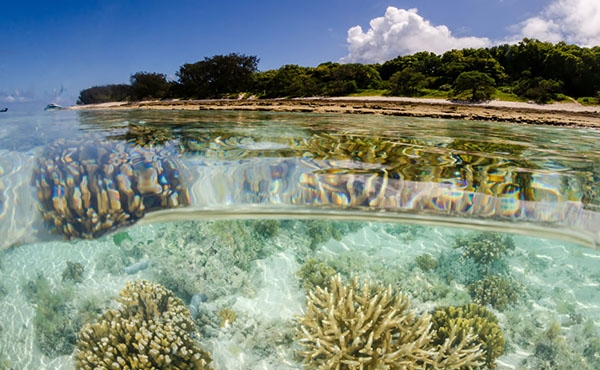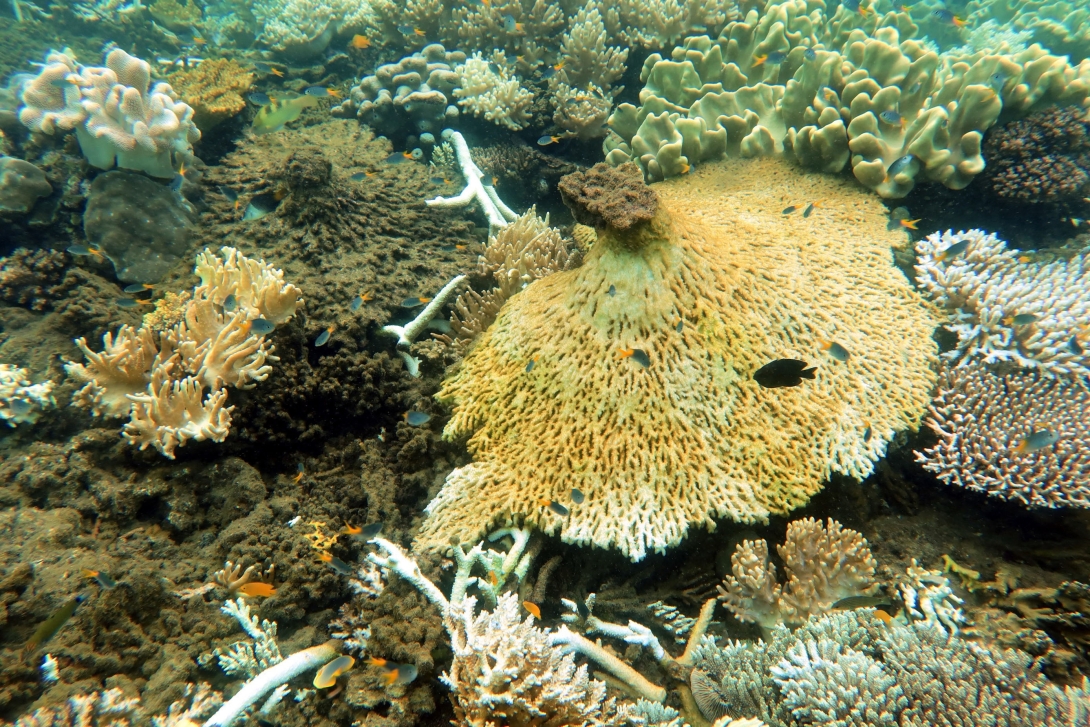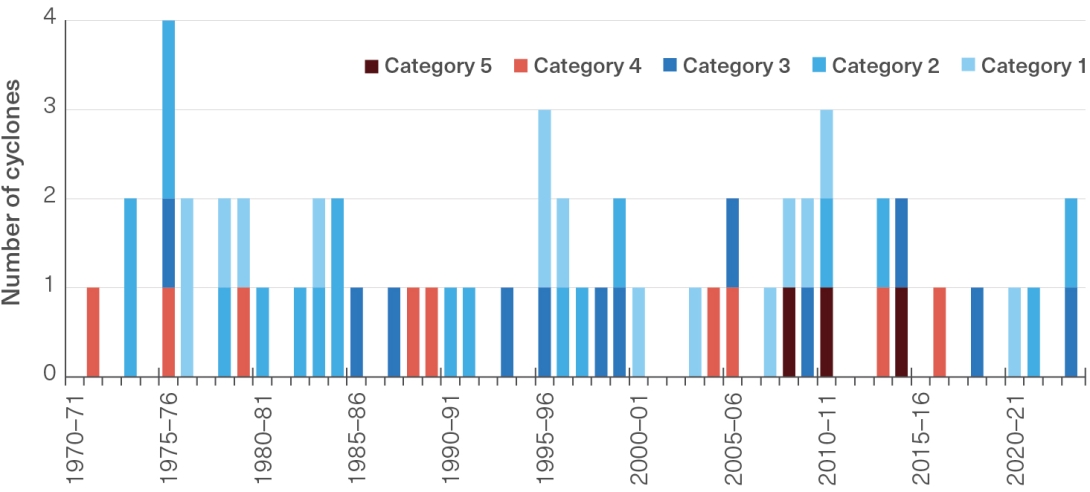179.
Lam, V.Y., Chaloupka, M., Thompson, A., Doropoulos, C. and Mumby, P.J. 2018, Acute drivers influence recent inshore Great Barrier Reef dynamics, Proceedings of the Royal Society B 285(1890): 20182063.
435.
Shine, R., Brown, G.P. and Goiran, C. 2022, Divergence in life-history traits among three adjoining populations of the sea snake Emydocephalus annulatus (Hydrophiinae, Elapidae), Scientific Reports 12(1): 5137.
537.
Wolff, N.H., Wong, A., Vitolo, R., Stolberg, K., Anthony, K.R., et al. 2016, Temporal clustering of tropical cyclones on the Great Barrier Reef and its ecological importance, Coral Reefs 35: 613-623.
538.
Ramsay, H.A., Camargo, S.J. and Kim, D. 2012, Cluster analysis of tropical cyclone tracks in the Southern Hemisphere, Climate Dynamics 39: 897-917.
539.
Lin, I., Camargo, S.J., Patricola, C.M., Boucharel, J., Chand, S., Klotzbach, P., Chan, J.C.L., Wang, B., Chang, P., Li, T. and Jin, F. 2020, ENSO and Tropical Cyclones, in El Niño Southern Oscillation in a Changing Climate, eds M.J. McPhaden, A. Santoso and W. Cai, American Geophysical Union, United States, pp. 377-408.
540.
CSIRO and The Bureau of Meteorology 2022, State of the Climate 2022.
541.
Cheal, A.J., MacNeil, M.A., Emslie, M.J. and Sweatman, H. 2017, The threat to coral reefs from more intense cyclones under climate change, Global Change Biology 23(4): 1511-1524.
542.
Wang, G., Wu, L., Mei, W. and Xie, S. 2022, Ocean currents show global intensification of weak tropical cyclones, Nature 611(7936): 496-500.
543.
Emanuel, K. 2021, Response of global tropical cyclone activity to increasing CO 2: Results from downscaling CMIP6 models, Journal of Climate 34(1): 57-70.
544.
Beeden, R., Maynard, J., Puotinen, M., Marshall, P., Dryden, J., et al. 2015, Impacts and recovery from severe Tropical Cyclone Yasi on the Great Barrier Reef, PloS One 10(4): e0121272.
545.
Massel, S.R. and Done, T.J. 1993, Effects of cyclone waves on massive coral assemblages on the Great Barrier Reef: meteorology, hydrodynamics and demography, Coral Reefs 12: 153-166.
546.
Harmelin-Vivien, M.L. 1994, The effects of storms and cyclones on coral reefs: a review, Journal of Coastal Research: 211-231.
547.
Halford, A., Cheal, A.J., Ryan, D. and Williams, D.M. 2004, Resilience to large‐scale disturbance in coral and fish assemblages on the Great Barrier Reef, Ecology 85(7): 1892-1905.
548.
Ceccarelli, D.M., McLeod, I.M., Boström-Einarsson, L., Bryan, S.E., Chartrand, K.M., et al. 2020, Substrate stabilisation and small structures in coral restoration: state of knowledge, and considerations for management and implementation, PLoS ONE 15(10): e0240846.
549.
Dixon, A.M., Puotinen, M., Ramsay, H.A. and Beger, M. 2022, Coral reef exposure to damaging tropical cyclone waves in a warming climate, Earth's Future 10(8): e2021EF002600.
550.
Kossin, J.P., Emanuel, K.A. and Vecchi, G.A. 2014, The poleward migration of the location of tropical cyclone maximum intensity, Nature 509: 349-352.
551.
Daloz, A.S. and Camargo, S.J. 2018, Is the poleward migration of tropical cyclone maximum intensity associated with a poleward migration of tropical cyclone genesis? Climate Dynamics 50(1-2): 705-715.
552.
Studholme, J., Fedorov, A.V., Gulev, S.K., Emanuel, K. and Hodges, K. 2022, Poleward expansion of tropical cyclone latitudes in warming climates, Nature Geoscience 15(1): 14-28.
553.
Knutson, T., Camargo, S.J., Chan, J.C.L., Emanuel, K., Ho, C., et al. 2020, Tropical cyclones and climate change assessment: part II: projected response to anthropogenic warming, Bulletin of the American Meteorological Society 101(3): E303-E322.
554.
Yaddanapudi, R., Mishra, A., Huang, W. and Chowdhary, H. 2022, Compound wind and precipitation extremes in global coastal regions under climate change, Geophysical Research Letters 49(15): e2022GL098974.
555.
Carrigan, A.D. and Puotinen, M. 2014, Tropical cyclone cooling combats region‐wide coral bleaching, Global Change Biology 20(5): 1604-1613.
556.
Leahy, S.M., Kingsford, M.J. and Steinberg, C.R. 2013, Do clouds save the Great Barrier Reef? Satellite imagery elucidates the cloud-SST relationship at the local scale, PLoS One 8(7): e70400.
-
-
-
-
561.
Critchell, K., Grech, A., Schlaefer, J., Andutta, F.P., Lambrechts, J., et al. 2015, Modelling the fate of marine debris along a complex shoreline: Lessons from the Great Barrier Reef, Estuarine, Coastal and Shelf Science 167: 414-426.
562.
Russell, B.C., Anderson, G.R.V. and Talbot, F.H. 1977, Seasonality and recruitment of coral reef fishes, Marine and Freshwater Research 28(4): 521-528.
563.
Nathan, R., Schurr, F.M., Spiegel, O., Steinitz, O., Trakhtenbrot, A., et al. 2008, Mechanisms of long-distance seed dispersal, Trends in Ecology & Evolution 23(11): 638-647.
564.
Cowen, R.K. 2002, Larval dispersal and retention and consequences for population connectivity in Coral reef fishes: dynamics and diversity in a complex ecosystem, ed. P.F. Sale, Academic press, pp. 149–170.
565.
Moise, A., Abbs, D., Bhend, J., Chiew, F., Church, J., et al. 2015, Monsoonal north cluster report. Climate change in Australia projections for Australia's natural resource management regions, CSIRO and Bureau of Meteorology, Australia.
566.
Dowdy, A., Abbs, D., Bhend, J., Chiew, F., Church, J., et al. 2015, East coast cluster report. Climate change in Australia projections for Australia's natural resource management regions, CSIRO and Bureau of Meteorology, Australia.
567.
Greene, S., Morrissey, M. and Johnson, S.E. 2010, Wind climatology, climate change, and wind energy, Geography Compass 4(11): 1592-1605.




